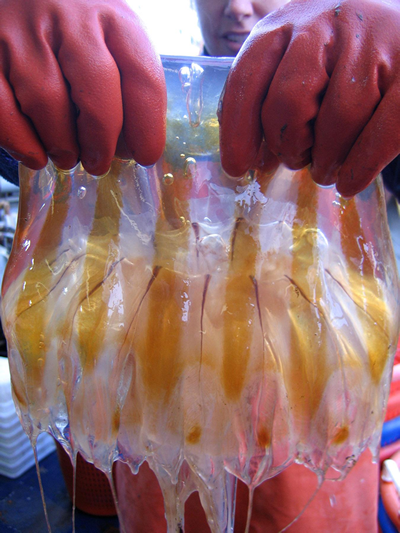 Large scyphozoan jellyfish feed on zooplankton and early life stages of fish; they are potentially important competitors and predators of fish. Eastern Bering Sea (EBS) fishery surveys indicate that jellyfish populations can grow dramatically and have fluctuated widely over the last 3 decades. These changes have been related to variability in climate and prey resources. An understanding of the role of jellyfish in the EBS is required for fishery and ecosystem management, however, we lack measurements of the direct and indirect impact of changes in jellyfish abundance on the ecosystem and the fish species it supports. The goals of this research are to estimate the scale and impact of competition between forage fish, and jellyfish in the EBS and to examine the role of jellyfish in the ecosystem as a predator and as an ecosystem structuring agent. To achieve these goals, we will quantify the predation potential of jellyfish upon zooplankton and the early life-history stages of fish, determine dietary and spatial overlap of jellyfish and forage fish, examine interannual relationships between fish production and indices of jellyfish biomass, examine the impact of jellyfish variability across all groups in the food web via ecosystem models, and compare the role of jellyfish in the EBS ecosystem with their role in other coastal ecosystems by coordinating with sister studies.
Large scyphozoan jellyfish feed on zooplankton and early life stages of fish; they are potentially important competitors and predators of fish. Eastern Bering Sea (EBS) fishery surveys indicate that jellyfish populations can grow dramatically and have fluctuated widely over the last 3 decades. These changes have been related to variability in climate and prey resources. An understanding of the role of jellyfish in the EBS is required for fishery and ecosystem management, however, we lack measurements of the direct and indirect impact of changes in jellyfish abundance on the ecosystem and the fish species it supports. The goals of this research are to estimate the scale and impact of competition between forage fish, and jellyfish in the EBS and to examine the role of jellyfish in the ecosystem as a predator and as an ecosystem structuring agent. To achieve these goals, we will quantify the predation potential of jellyfish upon zooplankton and the early life-history stages of fish, determine dietary and spatial overlap of jellyfish and forage fish, examine interannual relationships between fish production and indices of jellyfish biomass, examine the impact of jellyfish variability across all groups in the food web via ecosystem models, and compare the role of jellyfish in the EBS ecosystem with their role in other coastal ecosystems by coordinating with sister studies.
Collaborators: Ric Brodeur (NOAA/NWFSC), Kristin Cieciel (NOAA/AFSC) and Jim Ruzicka (OSU/NOAA) Sponsor: North Pacific Research Board